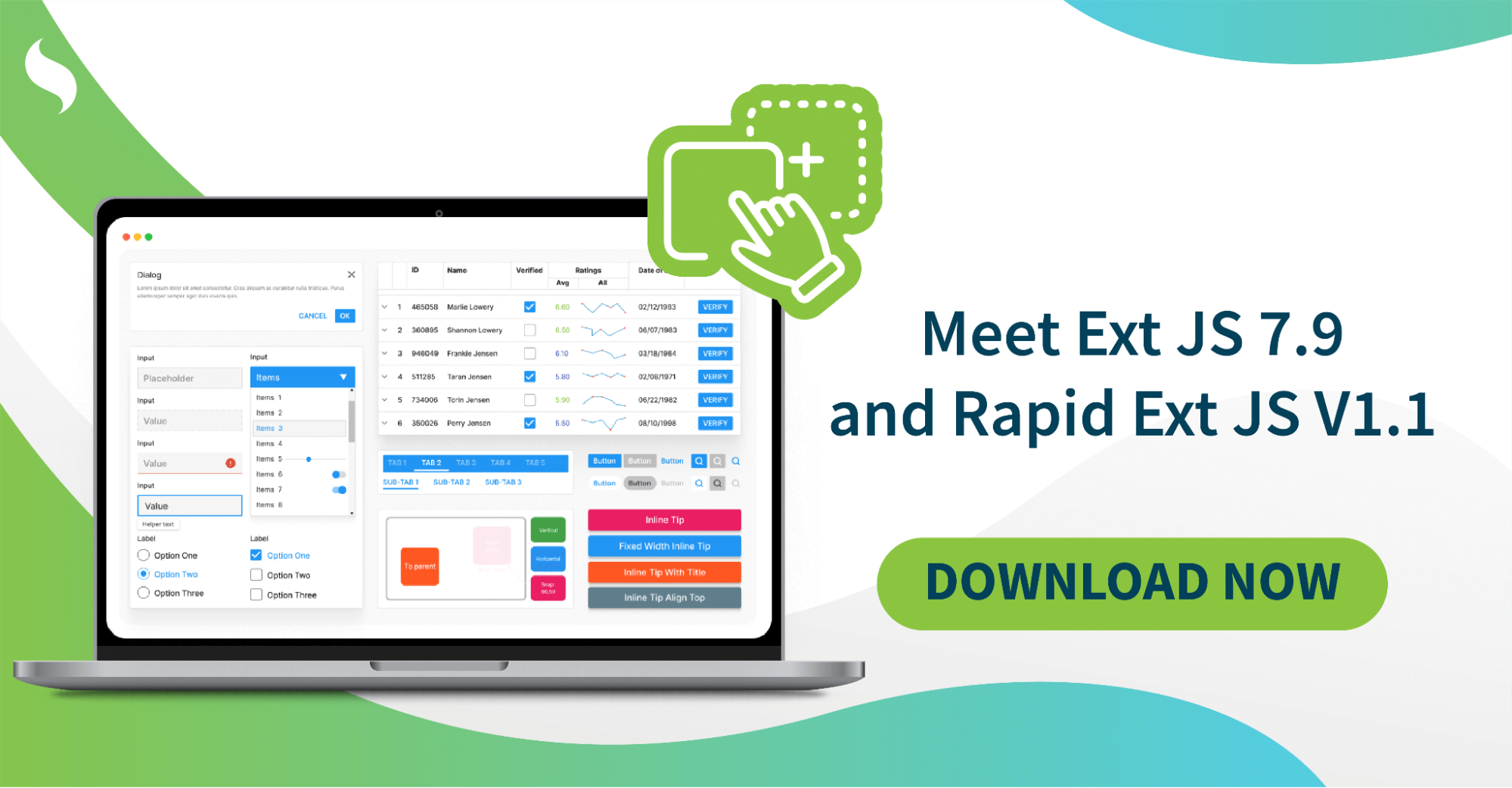Scaling Web Applications Through Custom Software Development

It is important to note that when your customers have a poor experience, they are 62% less likely to revisit. This gives an idea of the bad impact on customers due to a poor mobile experience. With this, you must know that scalability is essential to an application’s success. You need to design apps that are scalable enough to satisfy your customers.
In this blog, you will learn how scalability is essential to your business’s digital presence. We will also explore the importance of custom software development for scalability. The best part? It can help you create robust and adaptable applications.
But that’s not all we will learn. We will also introduce you to Ext JS, the best choice when you are thinking of creating data-rich applications. Moreover, we will also introduce you to techniques like load balancing and app architecture enhancement. These things can help you create efficient and scalable apps.
Let’s get started.

Understanding Scalability in Web Applications
Scalability in a web application context refers to how it accommodates increasing user demand. It maintains optimal availability and effectiveness. Along with responsiveness, the scalability of your business software includes responsiveness and processing power.
Applications can be scaled in two main ways: horizontal and vertical.
- Horizontal scaling is adding more servers to accommodate surge traffic.
- Vertical scaling is upgrading an existing server of a custom software development process.
Reliability, performance, and availability are the three main pillars of scalability.
Efficiency under heavy user demand defines your web app’s performance. Netflix, for example, relies on microservices to enable customers to stream video seamlessly, even when many people are watching at once.
Reliability is defined as not experiencing any technical failures in a custom software development project. Amazon has no problems managing the extremely high sales volume during Black Friday.
Availability is defined as constant uptime. Google Cloud guarantees access to its services even when parts of the infrastructure are experiencing problems.
When your user base grows, tuning scalability becomes very important. It allows your app to grow with the market demand without customer satisfaction or business health suffering.
Scalability also involves having foresight when planning your infrastructure. This includes picking the appropriate technology, code optimisation, and system preparation for growth.
From a business standpoint, scalability is an added market advantage. It enhances customer satisfaction while supporting sustained operational efficiency in the long run. Therefore, you need custom software development.

Challenges of Scaling Web Applications
Most systems, considering performance, have design bottlenecks when scaling. Your current app system may not ideally support the diverse scaling options available to businesses.
A classic example is Instagram, which had to shift to microservices to avoid constant performance issues.
Significant challenges come with data handling as well. It is not easy managing traffic and real-time data synchronization across numerous servers.
Shifts in traffic surges; for example, on Black Friday, Amazon is known to manage millions of requests using advanced request balance techniques. However, efficiently syncing data across servers remains a big problem.
Integration applications can arise while scaling. You may have to work with other software or API services. If a payment gateway cannot scale effectively, it can cause delays or failures to process transactions.
Cost control is another significantly important factor. Take Spotify, for example. As they scale, they have to balance performance against cost-effective growth with spending.
Ensure that performance, data, cost, integration factors, and other such functions are effectively addressed and managed so your system can support future growth while maintaining desired quality and profit margins.
Benefits of Custom Software Development for Scalability
Optimising custom software development services targeting custom solutions for your web application comes with many business advantages. Let’s discuss these challenges for web application development:
Custom Architecture to Meet Current and Future Demands
Custom architecture supports businesses in realising their growth goals. A study by Forrester showed an ROI of 379% over three years with Microsoft Fabric implementation. This approach aids in ensuring scalability, adaptability, and enduring performance with growth in the user base.
Control Over Performance Optimizations and Third-Party Integrations
Custom software is unique because it offers bespoke services and specific optimizations.
Integrations of third-party services become straightforward with custom solutions.
Microsoft’s spending on Azure infrastructure investments was related to a 31% revenue growth, illustrating the value of specific performance measures. Custom solutions offer businesses the flexibility of controlling system operations.
Long-Term ROI and Maintainability
Developing new systems provides a business with enormous financial value. It helps reduce value-draining activities through optimizations, especially in the long run.
Microsoft’s automated port has been capturing 228% ROI in 3 years from the investment. The payback period for adopting Azure PaaS was 15 months. Investment, running costs, and operational efforts substantiate the savings achieved through tailored systems.

Focusing custom architecture on a business helps it adapt to its future needs. It also gives the business more control over performance.
All of this leads to a highly scalable, maintainable, and profitable solution that meets both current and future business needs. Investing in custom software is the best long-term investment for a company.
Enhanced Security and Compliance Flexibility
Custom solutions offer enhanced security. They meet specific compliance system standards. For example, Microsoft Sentinel gave a 234% ROI, and users received better management for protection operations and compliance control.
Using Ext JS to Build Scalable and Data-Intensive Web Applications
For developers and tech leads, performance with customization capability makes Ext JS a boundless all-in-one solution.
Unlike React, which necessitates third-party grab libraries, everything is included with Ext JS. This is ideal for creating data-filled, responsive web applications.
Scalability and Speed
Ext JS makes scalability second nature. Its component pack is complete, ranging from data grids to advanced charts. Each part is customizable, enabling faster application development. There is no need to waste time and effort integrating multiple libraries.
Optimized Data Grids and Performance
With data grids in Ext JS, managing large datasets is a breeze. They break the data into smaller chunks. With lazy loading, data loads only when it is needed. This improves performance by minimizing initial load times, which is vital for applications with large datasets.
Advanced State Management
Ext JS offers built-in state management. The application can retain the last state and further users’ interactions with the app. This makes it easier for users to continue where they left off, even when using sophisticated applications. No need to add external state management tools.
Why Ext JS is Better for Faster Scaling
Using Ext JS can achieve faster scaling. Teams are given prefabricated parts, thus dedicating less time to preliminary configurations. It bolsters development by providing pre-built features. Teams can now concentrate on important functionalities of the core app instead.
Check out Sencha’s YouTube channel for videos and tutorials. These videos will help you adopt best practices and develop efficient and easy-to-scale apps quickly.
Developers looking for fast and scalable solutions will find Ext JS the best match. With its powerful components, state management, and performance optimization, Ext JS is the most effective framework for enabling faster scaling.

Key Considerations in Scaling Web Applications
Consider the following factors when scaling a web application or developing custom software solutions:
Performance Testing and Monitoring
Services such as Apache JMeter help simulate traffic to test if your app performs optimally during peak load periods. Implementing continuous performance monitoring is crucial to identify any potential issues before your users are negatively impacted.
Performance tuning needs to be accomplished before deploying systems into production so that they endure and respond gracefully to varying workloads. It’s also necessary to simulate various traffic patterns.
Modular Design and Microservices Architecture
Using modular designs along with microservices strategies shifts the paradigm of modern-day software applications.
Modular design involves dividing an application into smaller independent fragments, each of which is simple to scale on its own.
For example, Amazon allows order management and payment services to scale independently through distinct services. Individual components are able to quickly and easily scale independently of the entire system without skilled software engineers standing by in case issues occur.
This approach also enables rapid deployment since single-service teams don’t have to wait for the entire app to be ready.
Cloud Infrastructure and Autoscaling
Autoscaling and cloud infrastructure are key to effectively managing growth. For example, AWS and Azure have platforms that automatically scale resources as needed.
Services like Netflix use AWS to scale their platform during peak periods, such as during the holidays. By using cloud services, you can guarantee your infrastructure scales in real time. In real time, there are fewer chances of experiencing downtime or performance issues. With autoscaling, you improve efficiency by only paying for resources you utilize.
Security and Data Protection
The growth of your application comes with increased security risks. Implement effective measures and controls to manage access to user data and strong encryption.
Conduct regular audits and review security logs to detect gaps and vulnerabilities. These measures assist in complying with laws such as GDPR and safeguarding sensitive data.
You need to protect the application architecture first to avoid losing data or accessing services without authorization.
Applying strong measures from the start simplifies the burden of handling issues later on.
Continuous Integration and Testing
Continuous integration alongside automated testing ensures your application remains boundless during scaling. This embraces excellence as developers can detect bugs and vulnerabilities more easily with these processes in place.
Smooth sailing and fast releases fostered by CI/CD pipelines without downgrading quality are made possible due to more rapid time to market. This ensures more excellent uptime (less downtime or performance degradation) as the number of users increases.
Future Trends in Web App Scalability
Web application scalability allows developers to increase an app’s resource limit. This improves efficiency for users or organizations. Future trends promise easier, quicker ways for developers to adjust app resources.
Serverless Architecture and Edge Computing
Edge computing is offered as part of cloud computing and brings data processing closer to the user. Serverless architecture, such as AWS Lambda, exemplifies the direction of innovation in edge computing.
AWS Lambdas adapt to user demand by charging only for the compute time expended, ignoring content delivery, or scaling infrastructure using an economy of resource delivery.
Shift from Off-the-Shelf to Custom Software Solutions
The rise of ready-made software solutions enabled simple adoption. Organizations are moving from off-the-shelf software solutions towards advanced and more flexible tailored commercial software solutions. These include bespoke software development to more accurately address tailored business specifications.
Coca-Cola’s Scaling Efficiency
Coca-Cola software developers have enabled near real-time scaling of servers up or down. Edge computing allows for a reduction of latency by moving computation resources closer to users. Cloudflare accelerates the website’s loading time by pre-storing the data closer to the user.
AI-Assisted Scaling and Predictive Load Management
The integration of AI in scaling and workload redistribution has been beneficial. Google Cloud utilizes traffic trend prediction with AI-powered autoscaling. This feature permits changes to service provisioning to ensure application availability. Services are adjusted on the fly, so no scaling interventions are needed.
Low-Code Platforms and Full-Stack Frameworks
Development requires a low-code platform combined with a full-stack JavaScript framework. Tools like React and Node.js allow businesses to move rapidly, and their hands-free innovation capabilities enable teams to meet business objectives on time by developing custom software applications.
The Need for Custom Software Development
Customized software solutions are becoming increasingly common in business. Companies have been quickly moving towards custom development strategies rather than using off-the-shelf products to gain a competitive advantage.
Off-the-shelf products are accessible to everyone. At the same time, custom-made solutions allow for more effortless adaptability and flexible growth goals.
Conclusion
Scaling your web application in a business is essential. Custom software design addresses encountered problems by enabling the building of the right architecture, algorithms, and design. Performance, data management, and security require constant optimization and attention. Custom software design handles these problems easily, especially when building complex, data-heavy applications with tools like Ext JS custom software development company.
Cloud infrastructure and microservices support business expansion, and scaling is flexible. These technologies make it easy to increase data loads while maintaining adaptability.
The prospect of future scaling options looks bright. Key trends include AI-enabled scaling, serverless computing, and low-code platforms. Adopting these strategies will allow your application to scale with minimal friction as your business expands.
Remain proactive in your market and be wise about scaling your application. Business evolution is accompanied by application evolution to ensure longevity, which is captured through precise, efficient scaling.
FAQs
What Are the Common Challenges When Scaling Web Applications?
Some common scaling challenges include performance bottleneck, poor data handling, and data integration issues. However, you may use custom software development solutions to deal with these challenges.
What Technologies Are Typically Used in Scalable Web Applications?
Microservices, containerization, and cloud computing all contribute to developing scalable web applications.
What’s the Role of DevOps in Scaling Applications?
DevOps speeds up development and operational processes, simplifying the scaling and deployment of applications.

When it comes to developing robust, enterprise-grade web applications, Sencha provides some of the most…

The Sencha team is excited to announce the latest Ext JS version 7.9 and Rapid…

It is important to select the best app development software with proper instructions that enhance…










